Management Accounting: Systems, Methods, and Benefits
VerifiedAdded on 2023/01/11
|17
|3868
|87
AI Summary
This document provides an in-depth analysis of management accounting, including its systems, methods, and benefits. It explains the essential requirements of management accounting systems and different reporting methods. It also evaluates the benefits of management accounting systems and their application. The document further discusses the integration between systems and reporting under management accounting. The second part of the document focuses on budgeting, including the purpose and types of budgets.
Contribute Materials
Your contribution can guide someone’s learning journey. Share your
documents today.
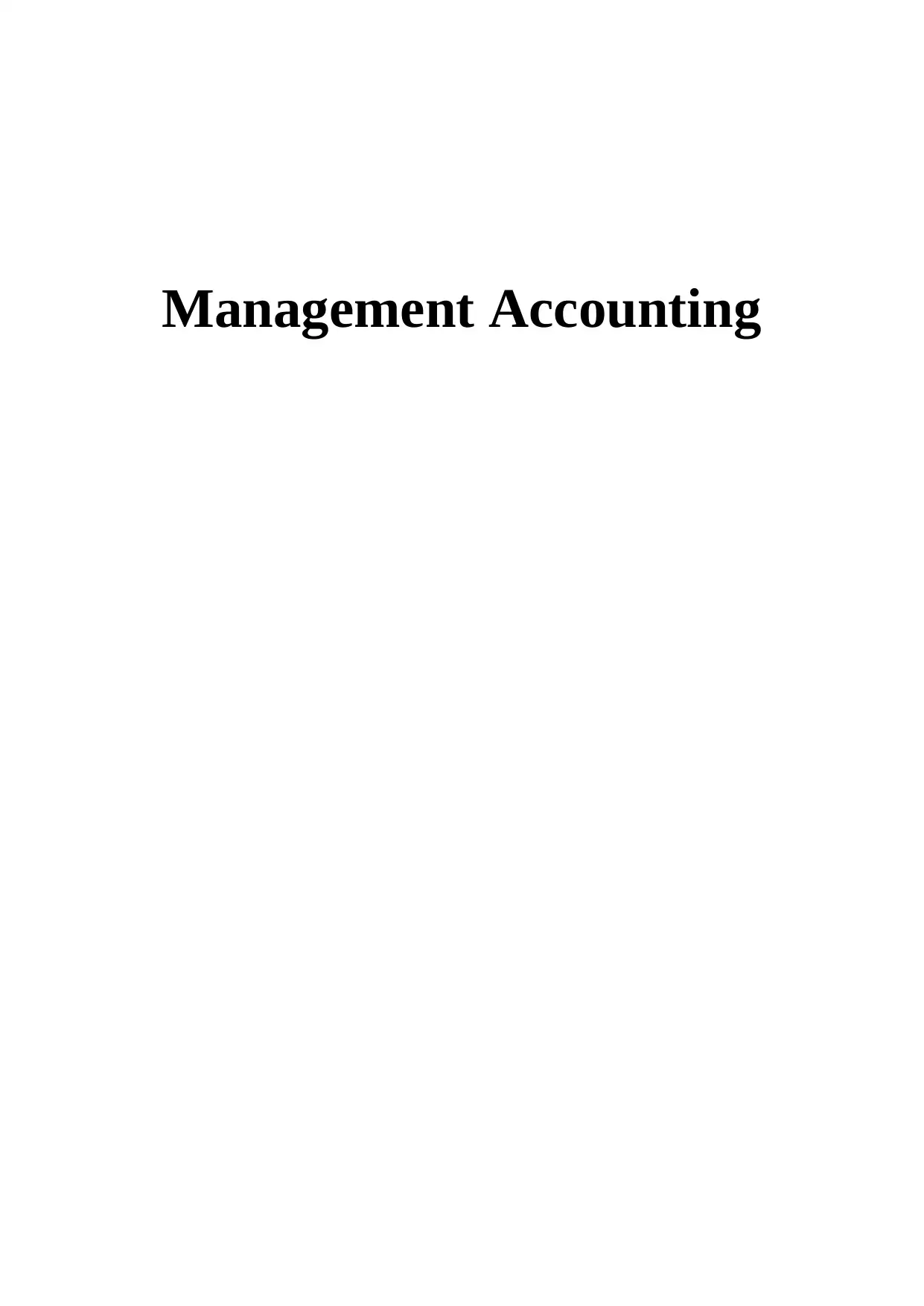
Management Accounting
Secure Best Marks with AI Grader
Need help grading? Try our AI Grader for instant feedback on your assignments.
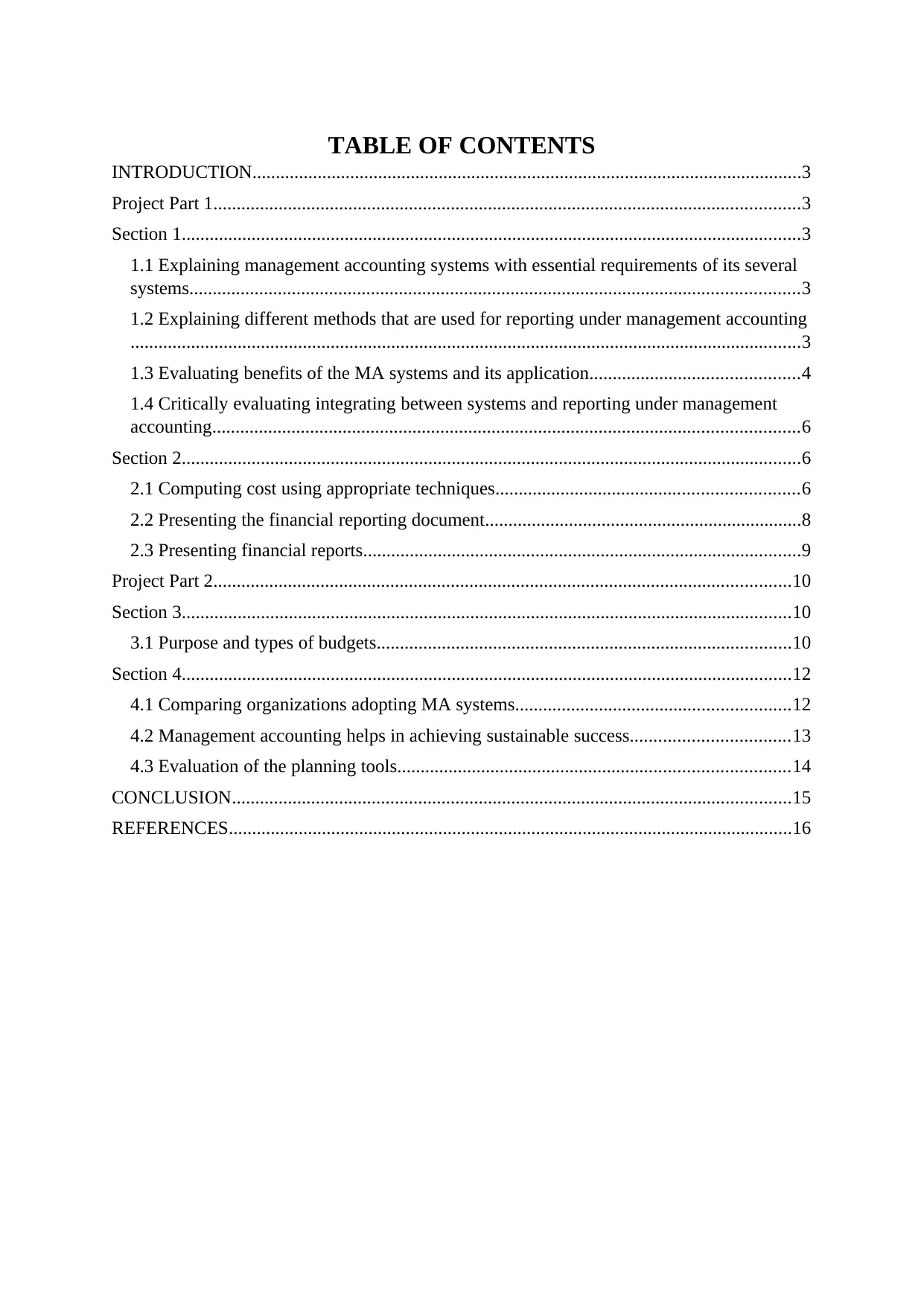
TABLE OF CONTENTS
INTRODUCTION......................................................................................................................3
Project Part 1..............................................................................................................................3
Section 1.....................................................................................................................................3
1.1 Explaining management accounting systems with essential requirements of its several
systems...................................................................................................................................3
1.2 Explaining different methods that are used for reporting under management accounting
................................................................................................................................................3
1.3 Evaluating benefits of the MA systems and its application.............................................4
1.4 Critically evaluating integrating between systems and reporting under management
accounting..............................................................................................................................6
Section 2.....................................................................................................................................6
2.1 Computing cost using appropriate techniques.................................................................6
2.2 Presenting the financial reporting document....................................................................8
2.3 Presenting financial reports..............................................................................................9
Project Part 2............................................................................................................................10
Section 3...................................................................................................................................10
3.1 Purpose and types of budgets.........................................................................................10
Section 4...................................................................................................................................12
4.1 Comparing organizations adopting MA systems...........................................................12
4.2 Management accounting helps in achieving sustainable success..................................13
4.3 Evaluation of the planning tools....................................................................................14
CONCLUSION........................................................................................................................15
REFERENCES.........................................................................................................................16
INTRODUCTION......................................................................................................................3
Project Part 1..............................................................................................................................3
Section 1.....................................................................................................................................3
1.1 Explaining management accounting systems with essential requirements of its several
systems...................................................................................................................................3
1.2 Explaining different methods that are used for reporting under management accounting
................................................................................................................................................3
1.3 Evaluating benefits of the MA systems and its application.............................................4
1.4 Critically evaluating integrating between systems and reporting under management
accounting..............................................................................................................................6
Section 2.....................................................................................................................................6
2.1 Computing cost using appropriate techniques.................................................................6
2.2 Presenting the financial reporting document....................................................................8
2.3 Presenting financial reports..............................................................................................9
Project Part 2............................................................................................................................10
Section 3...................................................................................................................................10
3.1 Purpose and types of budgets.........................................................................................10
Section 4...................................................................................................................................12
4.1 Comparing organizations adopting MA systems...........................................................12
4.2 Management accounting helps in achieving sustainable success..................................13
4.3 Evaluation of the planning tools....................................................................................14
CONCLUSION........................................................................................................................15
REFERENCES.........................................................................................................................16
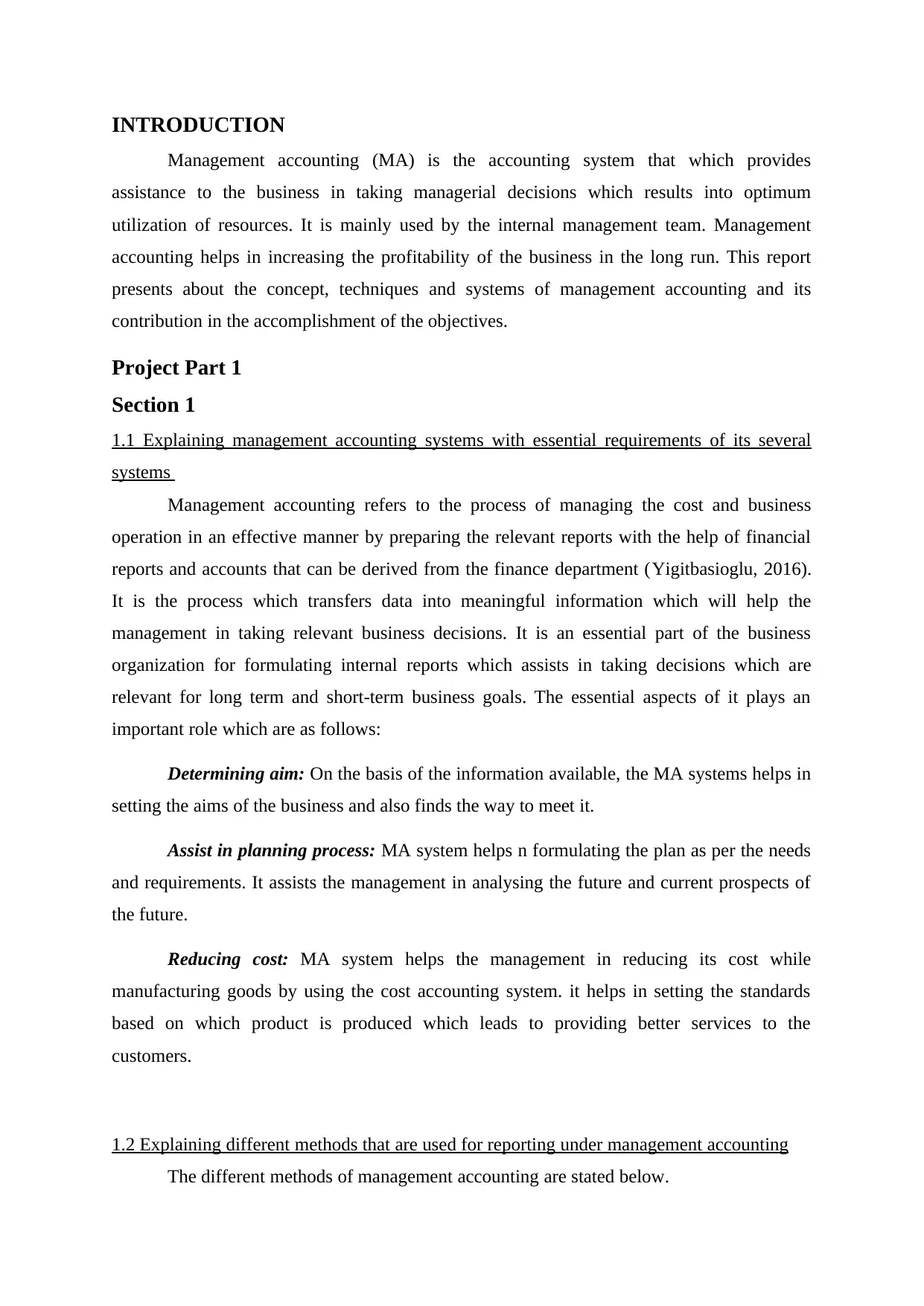
INTRODUCTION
Management accounting (MA) is the accounting system that which provides
assistance to the business in taking managerial decisions which results into optimum
utilization of resources. It is mainly used by the internal management team. Management
accounting helps in increasing the profitability of the business in the long run. This report
presents about the concept, techniques and systems of management accounting and its
contribution in the accomplishment of the objectives.
Project Part 1
Section 1
1.1 Explaining management accounting systems with essential requirements of its several
systems
Management accounting refers to the process of managing the cost and business
operation in an effective manner by preparing the relevant reports with the help of financial
reports and accounts that can be derived from the finance department (Yigitbasioglu, 2016).
It is the process which transfers data into meaningful information which will help the
management in taking relevant business decisions. It is an essential part of the business
organization for formulating internal reports which assists in taking decisions which are
relevant for long term and short-term business goals. The essential aspects of it plays an
important role which are as follows:
Determining aim: On the basis of the information available, the MA systems helps in
setting the aims of the business and also finds the way to meet it.
Assist in planning process: MA system helps n formulating the plan as per the needs
and requirements. It assists the management in analysing the future and current prospects of
the future.
Reducing cost: MA system helps the management in reducing its cost while
manufacturing goods by using the cost accounting system. it helps in setting the standards
based on which product is produced which leads to providing better services to the
customers.
1.2 Explaining different methods that are used for reporting under management accounting
The different methods of management accounting are stated below.
Management accounting (MA) is the accounting system that which provides
assistance to the business in taking managerial decisions which results into optimum
utilization of resources. It is mainly used by the internal management team. Management
accounting helps in increasing the profitability of the business in the long run. This report
presents about the concept, techniques and systems of management accounting and its
contribution in the accomplishment of the objectives.
Project Part 1
Section 1
1.1 Explaining management accounting systems with essential requirements of its several
systems
Management accounting refers to the process of managing the cost and business
operation in an effective manner by preparing the relevant reports with the help of financial
reports and accounts that can be derived from the finance department (Yigitbasioglu, 2016).
It is the process which transfers data into meaningful information which will help the
management in taking relevant business decisions. It is an essential part of the business
organization for formulating internal reports which assists in taking decisions which are
relevant for long term and short-term business goals. The essential aspects of it plays an
important role which are as follows:
Determining aim: On the basis of the information available, the MA systems helps in
setting the aims of the business and also finds the way to meet it.
Assist in planning process: MA system helps n formulating the plan as per the needs
and requirements. It assists the management in analysing the future and current prospects of
the future.
Reducing cost: MA system helps the management in reducing its cost while
manufacturing goods by using the cost accounting system. it helps in setting the standards
based on which product is produced which leads to providing better services to the
customers.
1.2 Explaining different methods that are used for reporting under management accounting
The different methods of management accounting are stated below.
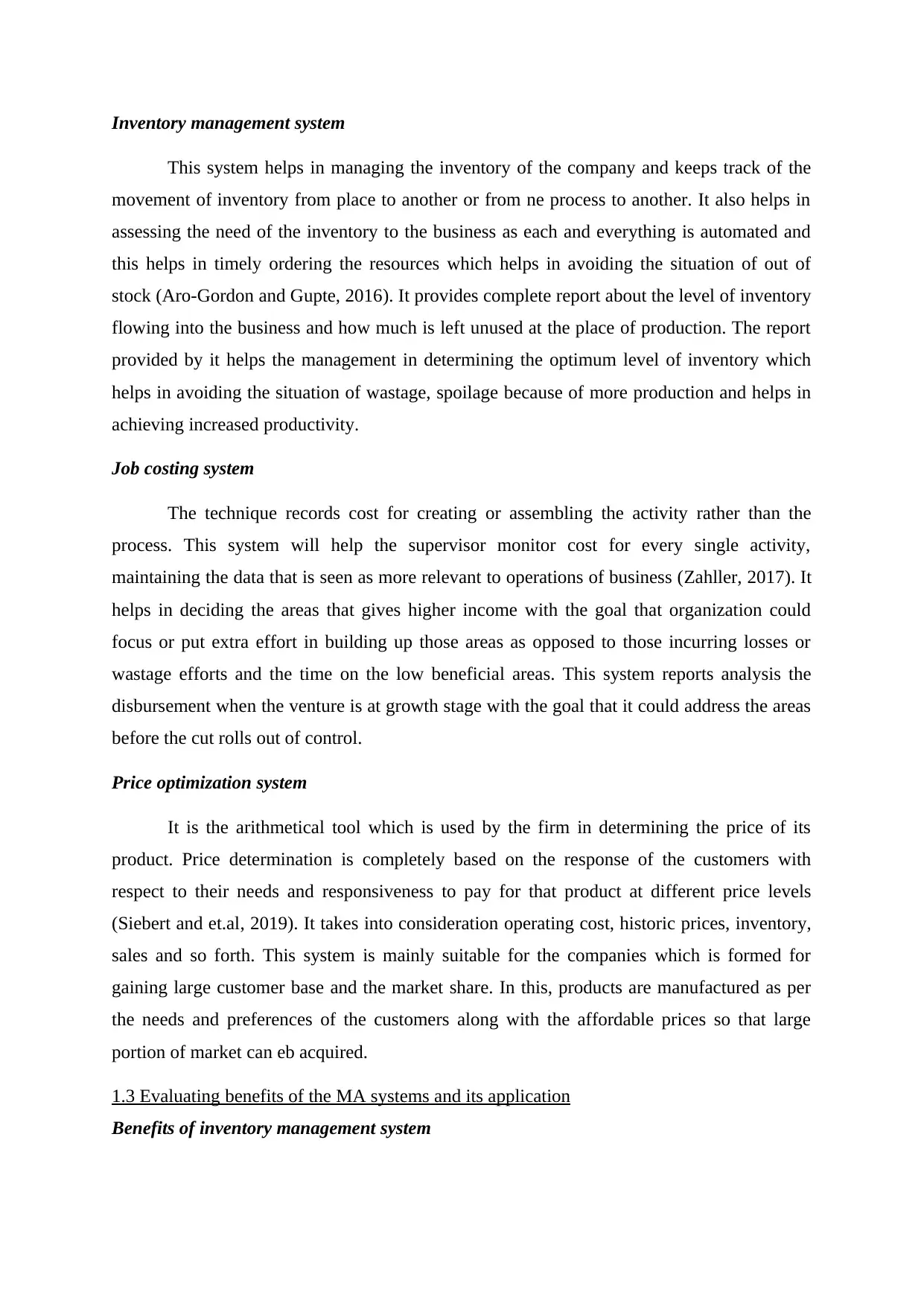
Inventory management system
This system helps in managing the inventory of the company and keeps track of the
movement of inventory from place to another or from ne process to another. It also helps in
assessing the need of the inventory to the business as each and everything is automated and
this helps in timely ordering the resources which helps in avoiding the situation of out of
stock (Aro-Gordon and Gupte, 2016). It provides complete report about the level of inventory
flowing into the business and how much is left unused at the place of production. The report
provided by it helps the management in determining the optimum level of inventory which
helps in avoiding the situation of wastage, spoilage because of more production and helps in
achieving increased productivity.
Job costing system
The technique records cost for creating or assembling the activity rather than the
process. This system will help the supervisor monitor cost for every single activity,
maintaining the data that is seen as more relevant to operations of business (Zahller, 2017). It
helps in deciding the areas that gives higher income with the goal that organization could
focus or put extra effort in building up those areas as opposed to those incurring losses or
wastage efforts and the time on the low beneficial areas. This system reports analysis the
disbursement when the venture is at growth stage with the goal that it could address the areas
before the cut rolls out of control.
Price optimization system
It is the arithmetical tool which is used by the firm in determining the price of its
product. Price determination is completely based on the response of the customers with
respect to their needs and responsiveness to pay for that product at different price levels
(Siebert and et.al, 2019). It takes into consideration operating cost, historic prices, inventory,
sales and so forth. This system is mainly suitable for the companies which is formed for
gaining large customer base and the market share. In this, products are manufactured as per
the needs and preferences of the customers along with the affordable prices so that large
portion of market can eb acquired.
1.3 Evaluating benefits of the MA systems and its application
Benefits of inventory management system
This system helps in managing the inventory of the company and keeps track of the
movement of inventory from place to another or from ne process to another. It also helps in
assessing the need of the inventory to the business as each and everything is automated and
this helps in timely ordering the resources which helps in avoiding the situation of out of
stock (Aro-Gordon and Gupte, 2016). It provides complete report about the level of inventory
flowing into the business and how much is left unused at the place of production. The report
provided by it helps the management in determining the optimum level of inventory which
helps in avoiding the situation of wastage, spoilage because of more production and helps in
achieving increased productivity.
Job costing system
The technique records cost for creating or assembling the activity rather than the
process. This system will help the supervisor monitor cost for every single activity,
maintaining the data that is seen as more relevant to operations of business (Zahller, 2017). It
helps in deciding the areas that gives higher income with the goal that organization could
focus or put extra effort in building up those areas as opposed to those incurring losses or
wastage efforts and the time on the low beneficial areas. This system reports analysis the
disbursement when the venture is at growth stage with the goal that it could address the areas
before the cut rolls out of control.
Price optimization system
It is the arithmetical tool which is used by the firm in determining the price of its
product. Price determination is completely based on the response of the customers with
respect to their needs and responsiveness to pay for that product at different price levels
(Siebert and et.al, 2019). It takes into consideration operating cost, historic prices, inventory,
sales and so forth. This system is mainly suitable for the companies which is formed for
gaining large customer base and the market share. In this, products are manufactured as per
the needs and preferences of the customers along with the affordable prices so that large
portion of market can eb acquired.
1.3 Evaluating benefits of the MA systems and its application
Benefits of inventory management system
Secure Best Marks with AI Grader
Need help grading? Try our AI Grader for instant feedback on your assignments.
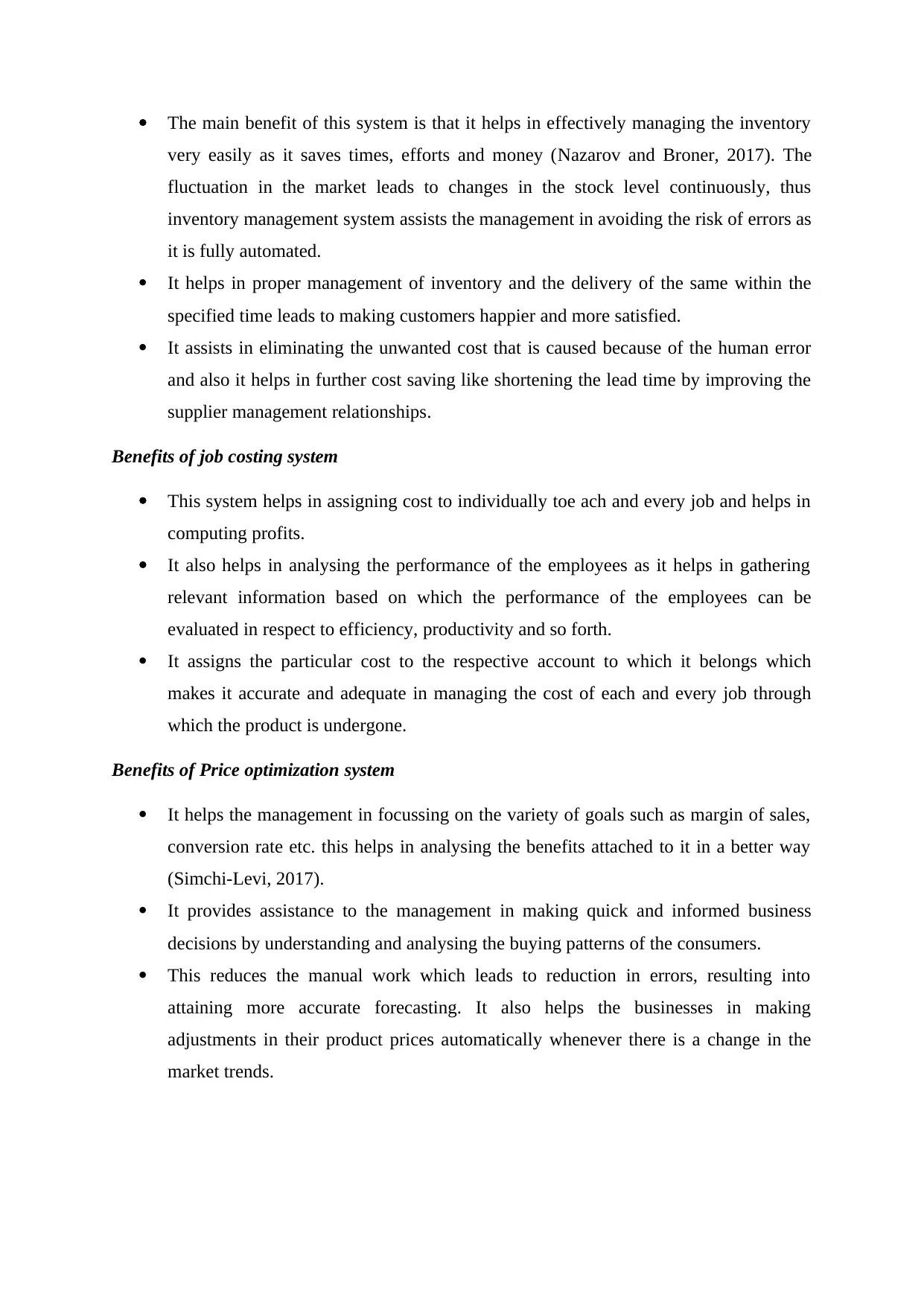
The main benefit of this system is that it helps in effectively managing the inventory
very easily as it saves times, efforts and money (Nazarov and Broner, 2017). The
fluctuation in the market leads to changes in the stock level continuously, thus
inventory management system assists the management in avoiding the risk of errors as
it is fully automated.
It helps in proper management of inventory and the delivery of the same within the
specified time leads to making customers happier and more satisfied.
It assists in eliminating the unwanted cost that is caused because of the human error
and also it helps in further cost saving like shortening the lead time by improving the
supplier management relationships.
Benefits of job costing system
This system helps in assigning cost to individually toe ach and every job and helps in
computing profits.
It also helps in analysing the performance of the employees as it helps in gathering
relevant information based on which the performance of the employees can be
evaluated in respect to efficiency, productivity and so forth.
It assigns the particular cost to the respective account to which it belongs which
makes it accurate and adequate in managing the cost of each and every job through
which the product is undergone.
Benefits of Price optimization system
It helps the management in focussing on the variety of goals such as margin of sales,
conversion rate etc. this helps in analysing the benefits attached to it in a better way
(Simchi-Levi, 2017).
It provides assistance to the management in making quick and informed business
decisions by understanding and analysing the buying patterns of the consumers.
This reduces the manual work which leads to reduction in errors, resulting into
attaining more accurate forecasting. It also helps the businesses in making
adjustments in their product prices automatically whenever there is a change in the
market trends.
very easily as it saves times, efforts and money (Nazarov and Broner, 2017). The
fluctuation in the market leads to changes in the stock level continuously, thus
inventory management system assists the management in avoiding the risk of errors as
it is fully automated.
It helps in proper management of inventory and the delivery of the same within the
specified time leads to making customers happier and more satisfied.
It assists in eliminating the unwanted cost that is caused because of the human error
and also it helps in further cost saving like shortening the lead time by improving the
supplier management relationships.
Benefits of job costing system
This system helps in assigning cost to individually toe ach and every job and helps in
computing profits.
It also helps in analysing the performance of the employees as it helps in gathering
relevant information based on which the performance of the employees can be
evaluated in respect to efficiency, productivity and so forth.
It assigns the particular cost to the respective account to which it belongs which
makes it accurate and adequate in managing the cost of each and every job through
which the product is undergone.
Benefits of Price optimization system
It helps the management in focussing on the variety of goals such as margin of sales,
conversion rate etc. this helps in analysing the benefits attached to it in a better way
(Simchi-Levi, 2017).
It provides assistance to the management in making quick and informed business
decisions by understanding and analysing the buying patterns of the consumers.
This reduces the manual work which leads to reduction in errors, resulting into
attaining more accurate forecasting. It also helps the businesses in making
adjustments in their product prices automatically whenever there is a change in the
market trends.
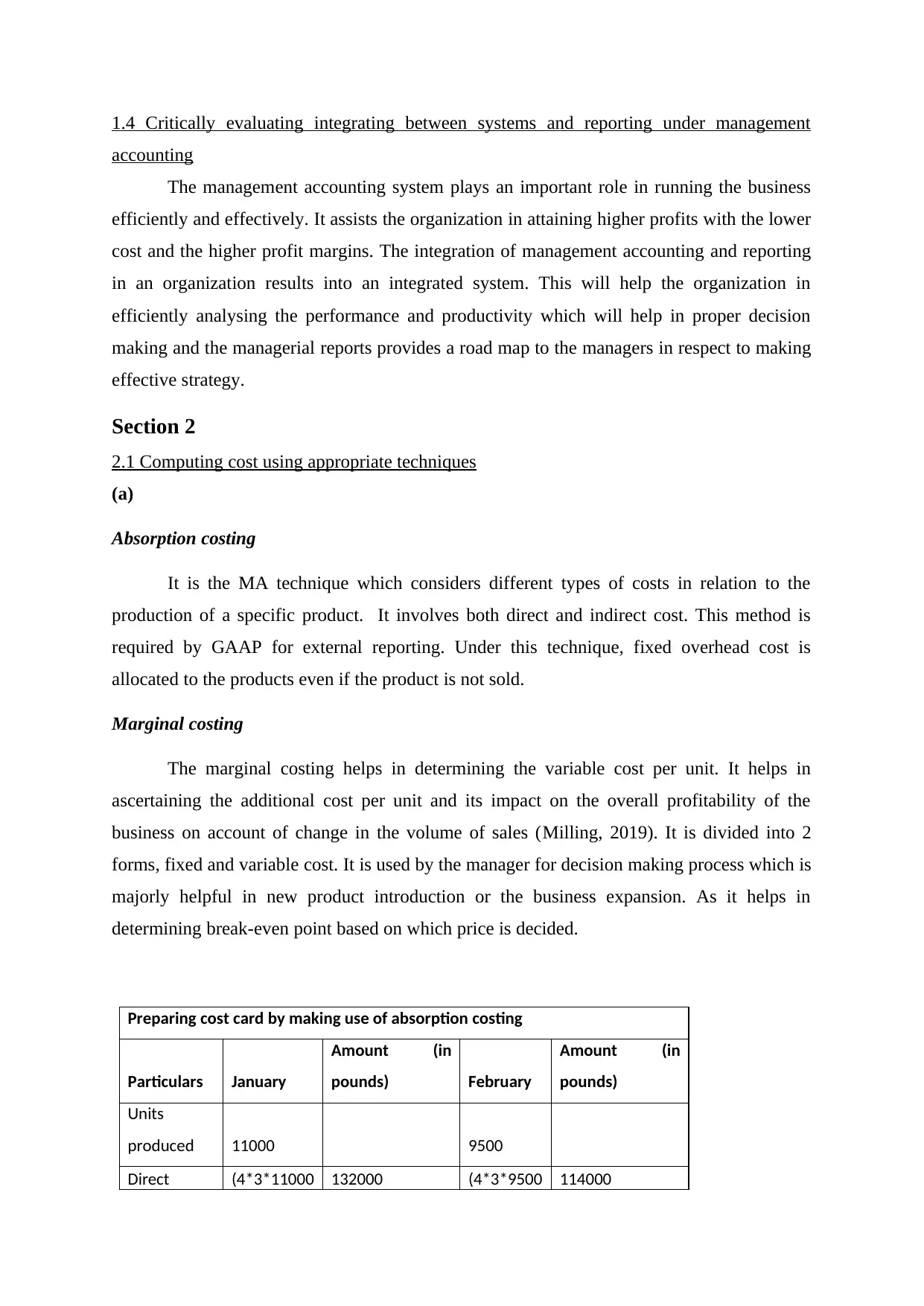
1.4 Critically evaluating integrating between systems and reporting under management
accounting
The management accounting system plays an important role in running the business
efficiently and effectively. It assists the organization in attaining higher profits with the lower
cost and the higher profit margins. The integration of management accounting and reporting
in an organization results into an integrated system. This will help the organization in
efficiently analysing the performance and productivity which will help in proper decision
making and the managerial reports provides a road map to the managers in respect to making
effective strategy.
Section 2
2.1 Computing cost using appropriate techniques
(a)
Absorption costing
It is the MA technique which considers different types of costs in relation to the
production of a specific product. It involves both direct and indirect cost. This method is
required by GAAP for external reporting. Under this technique, fixed overhead cost is
allocated to the products even if the product is not sold.
Marginal costing
The marginal costing helps in determining the variable cost per unit. It helps in
ascertaining the additional cost per unit and its impact on the overall profitability of the
business on account of change in the volume of sales (Milling, 2019). It is divided into 2
forms, fixed and variable cost. It is used by the manager for decision making process which is
majorly helpful in new product introduction or the business expansion. As it helps in
determining break-even point based on which price is decided.
Preparing cost card by making use of absorption costing
Particulars January
Amount (in
pounds) February
Amount (in
pounds)
Units
produced 11000 9500
Direct (4*3*11000 132000 (4*3*9500 114000
accounting
The management accounting system plays an important role in running the business
efficiently and effectively. It assists the organization in attaining higher profits with the lower
cost and the higher profit margins. The integration of management accounting and reporting
in an organization results into an integrated system. This will help the organization in
efficiently analysing the performance and productivity which will help in proper decision
making and the managerial reports provides a road map to the managers in respect to making
effective strategy.
Section 2
2.1 Computing cost using appropriate techniques
(a)
Absorption costing
It is the MA technique which considers different types of costs in relation to the
production of a specific product. It involves both direct and indirect cost. This method is
required by GAAP for external reporting. Under this technique, fixed overhead cost is
allocated to the products even if the product is not sold.
Marginal costing
The marginal costing helps in determining the variable cost per unit. It helps in
ascertaining the additional cost per unit and its impact on the overall profitability of the
business on account of change in the volume of sales (Milling, 2019). It is divided into 2
forms, fixed and variable cost. It is used by the manager for decision making process which is
majorly helpful in new product introduction or the business expansion. As it helps in
determining break-even point based on which price is decided.
Preparing cost card by making use of absorption costing
Particulars January
Amount (in
pounds) February
Amount (in
pounds)
Units
produced 11000 9500
Direct (4*3*11000 132000 (4*3*9500 114000
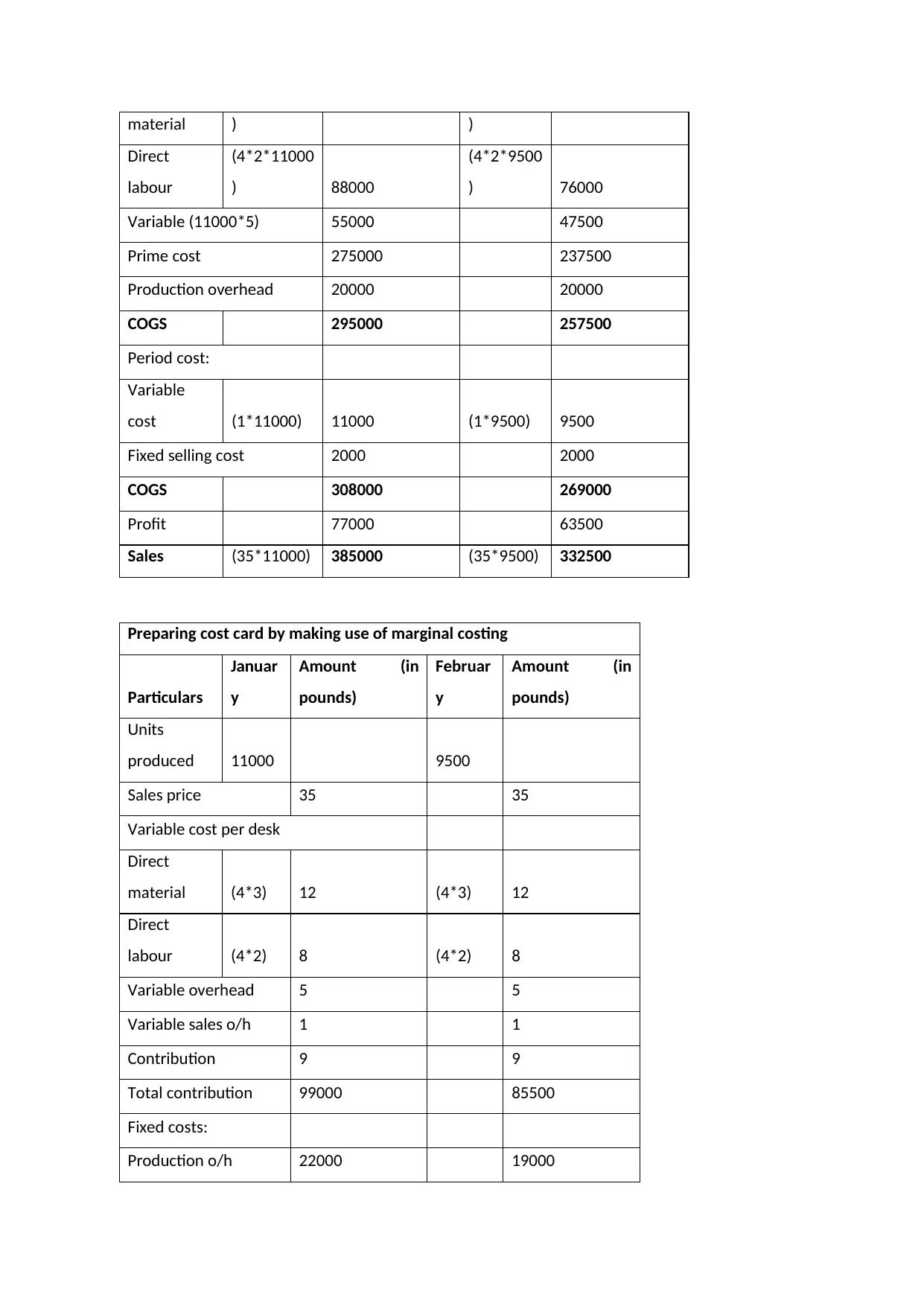
material ) )
Direct
labour
(4*2*11000
) 88000
(4*2*9500
) 76000
Variable (11000*5) 55000 47500
Prime cost 275000 237500
Production overhead 20000 20000
COGS 295000 257500
Period cost:
Variable
cost (1*11000) 11000 (1*9500) 9500
Fixed selling cost 2000 2000
COGS 308000 269000
Profit 77000 63500
Sales (35*11000) 385000 (35*9500) 332500
Preparing cost card by making use of marginal costing
Particulars
Januar
y
Amount (in
pounds)
Februar
y
Amount (in
pounds)
Units
produced 11000 9500
Sales price 35 35
Variable cost per desk
Direct
material (4*3) 12 (4*3) 12
Direct
labour (4*2) 8 (4*2) 8
Variable overhead 5 5
Variable sales o/h 1 1
Contribution 9 9
Total contribution 99000 85500
Fixed costs:
Production o/h 22000 19000
Direct
labour
(4*2*11000
) 88000
(4*2*9500
) 76000
Variable (11000*5) 55000 47500
Prime cost 275000 237500
Production overhead 20000 20000
COGS 295000 257500
Period cost:
Variable
cost (1*11000) 11000 (1*9500) 9500
Fixed selling cost 2000 2000
COGS 308000 269000
Profit 77000 63500
Sales (35*11000) 385000 (35*9500) 332500
Preparing cost card by making use of marginal costing
Particulars
Januar
y
Amount (in
pounds)
Februar
y
Amount (in
pounds)
Units
produced 11000 9500
Sales price 35 35
Variable cost per desk
Direct
material (4*3) 12 (4*3) 12
Direct
labour (4*2) 8 (4*2) 8
Variable overhead 5 5
Variable sales o/h 1 1
Contribution 9 9
Total contribution 99000 85500
Fixed costs:
Production o/h 22000 19000
Paraphrase This Document
Need a fresh take? Get an instant paraphrase of this document with our AI Paraphraser
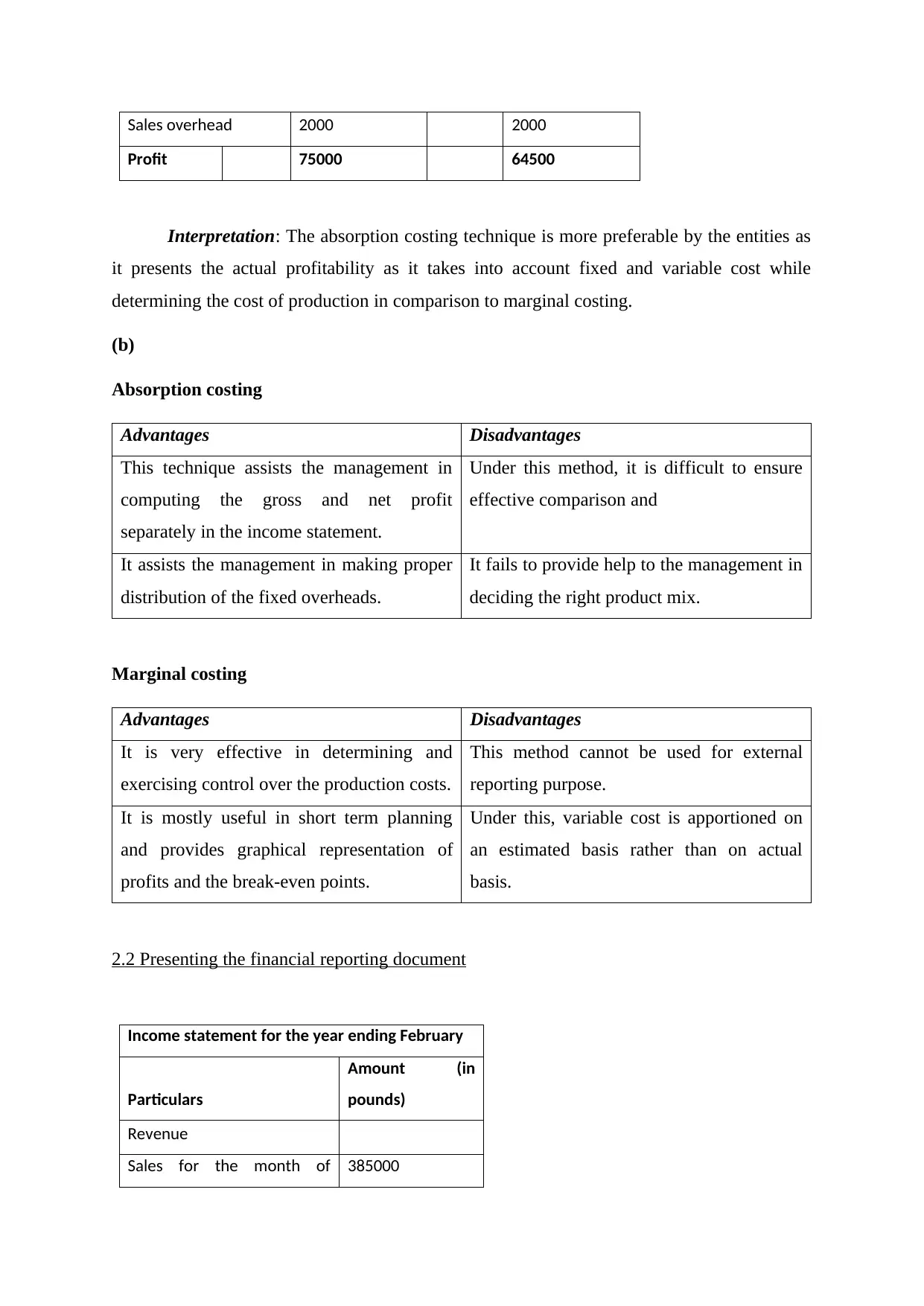
Sales overhead 2000 2000
Profit 75000 64500
Interpretation: The absorption costing technique is more preferable by the entities as
it presents the actual profitability as it takes into account fixed and variable cost while
determining the cost of production in comparison to marginal costing.
(b)
Absorption costing
Advantages Disadvantages
This technique assists the management in
computing the gross and net profit
separately in the income statement.
Under this method, it is difficult to ensure
effective comparison and
It assists the management in making proper
distribution of the fixed overheads.
It fails to provide help to the management in
deciding the right product mix.
Marginal costing
Advantages Disadvantages
It is very effective in determining and
exercising control over the production costs.
This method cannot be used for external
reporting purpose.
It is mostly useful in short term planning
and provides graphical representation of
profits and the break-even points.
Under this, variable cost is apportioned on
an estimated basis rather than on actual
basis.
2.2 Presenting the financial reporting document
Income statement for the year ending February
Particulars
Amount (in
pounds)
Revenue
Sales for the month of 385000
Profit 75000 64500
Interpretation: The absorption costing technique is more preferable by the entities as
it presents the actual profitability as it takes into account fixed and variable cost while
determining the cost of production in comparison to marginal costing.
(b)
Absorption costing
Advantages Disadvantages
This technique assists the management in
computing the gross and net profit
separately in the income statement.
Under this method, it is difficult to ensure
effective comparison and
It assists the management in making proper
distribution of the fixed overheads.
It fails to provide help to the management in
deciding the right product mix.
Marginal costing
Advantages Disadvantages
It is very effective in determining and
exercising control over the production costs.
This method cannot be used for external
reporting purpose.
It is mostly useful in short term planning
and provides graphical representation of
profits and the break-even points.
Under this, variable cost is apportioned on
an estimated basis rather than on actual
basis.
2.2 Presenting the financial reporting document
Income statement for the year ending February
Particulars
Amount (in
pounds)
Revenue
Sales for the month of 385000
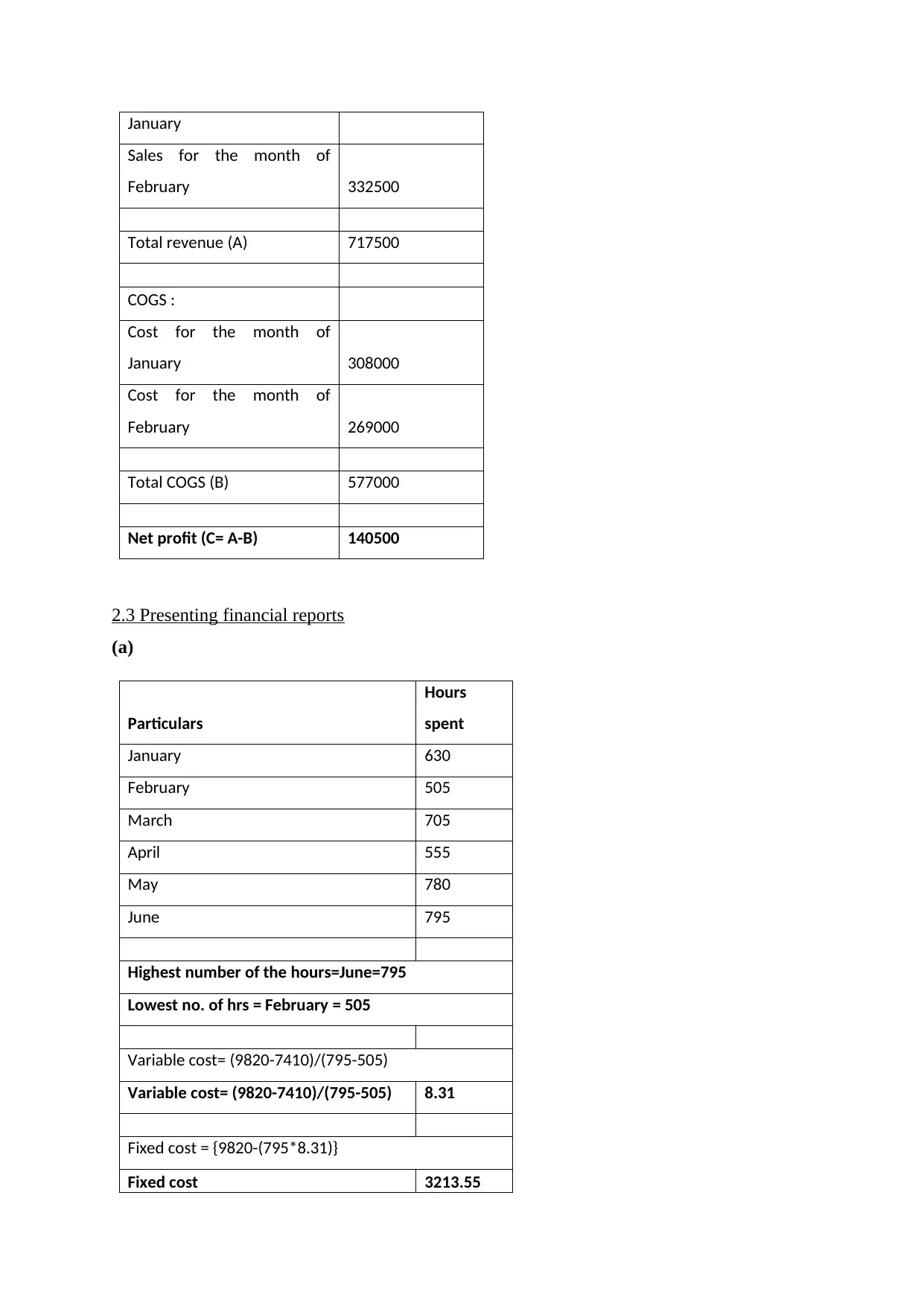
January
Sales for the month of
February 332500
Total revenue (A) 717500
COGS :
Cost for the month of
January 308000
Cost for the month of
February 269000
Total COGS (B) 577000
Net profit (C= A-B) 140500
2.3 Presenting financial reports
(a)
Particulars
Hours
spent
January 630
February 505
March 705
April 555
May 780
June 795
Highest number of the hours=June=795
Lowest no. of hrs = February = 505
Variable cost= (9820-7410)/(795-505)
Variable cost= (9820-7410)/(795-505) 8.31
Fixed cost = {9820-(795*8.31)}
Fixed cost 3213.55
Sales for the month of
February 332500
Total revenue (A) 717500
COGS :
Cost for the month of
January 308000
Cost for the month of
February 269000
Total COGS (B) 577000
Net profit (C= A-B) 140500
2.3 Presenting financial reports
(a)
Particulars
Hours
spent
January 630
February 505
March 705
April 555
May 780
June 795
Highest number of the hours=June=795
Lowest no. of hrs = February = 505
Variable cost= (9820-7410)/(795-505)
Variable cost= (9820-7410)/(795-505) 8.31
Fixed cost = {9820-(795*8.31)}
Fixed cost 3213.55
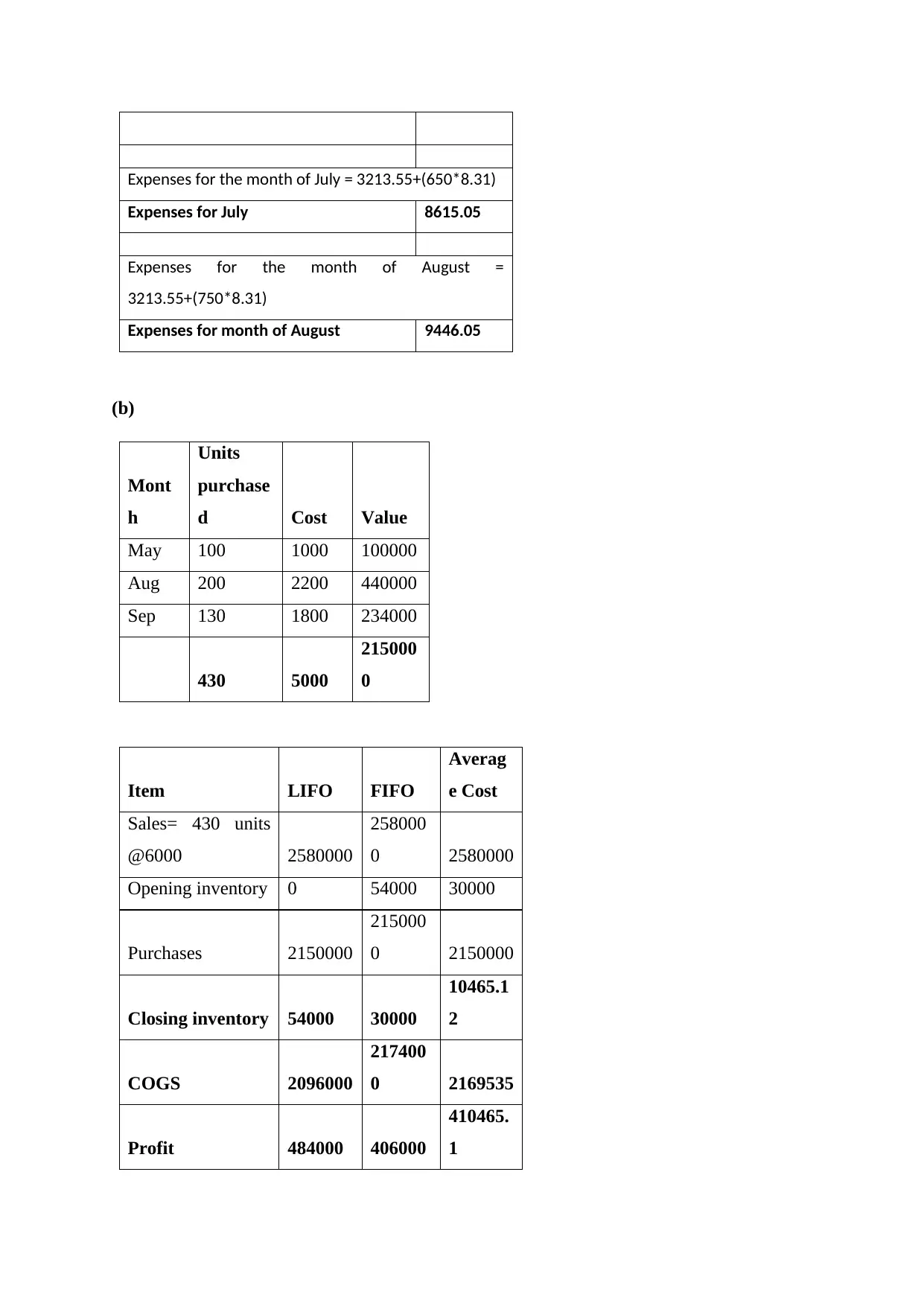
Expenses for the month of July = 3213.55+(650*8.31)
Expenses for July 8615.05
Expenses for the month of August =
3213.55+(750*8.31)
Expenses for month of August 9446.05
(b)
Mont
h
Units
purchase
d Cost Value
May 100 1000 100000
Aug 200 2200 440000
Sep 130 1800 234000
430 5000
215000
0
Item LIFO FIFO
Averag
e Cost
Sales= 430 units
@6000 2580000
258000
0 2580000
Opening inventory 0 54000 30000
Purchases 2150000
215000
0 2150000
Closing inventory 54000 30000
10465.1
2
COGS 2096000
217400
0 2169535
Profit 484000 406000
410465.
1
Expenses for July 8615.05
Expenses for the month of August =
3213.55+(750*8.31)
Expenses for month of August 9446.05
(b)
Mont
h
Units
purchase
d Cost Value
May 100 1000 100000
Aug 200 2200 440000
Sep 130 1800 234000
430 5000
215000
0
Item LIFO FIFO
Averag
e Cost
Sales= 430 units
@6000 2580000
258000
0 2580000
Opening inventory 0 54000 30000
Purchases 2150000
215000
0 2150000
Closing inventory 54000 30000
10465.1
2
COGS 2096000
217400
0 2169535
Profit 484000 406000
410465.
1
Secure Best Marks with AI Grader
Need help grading? Try our AI Grader for instant feedback on your assignments.
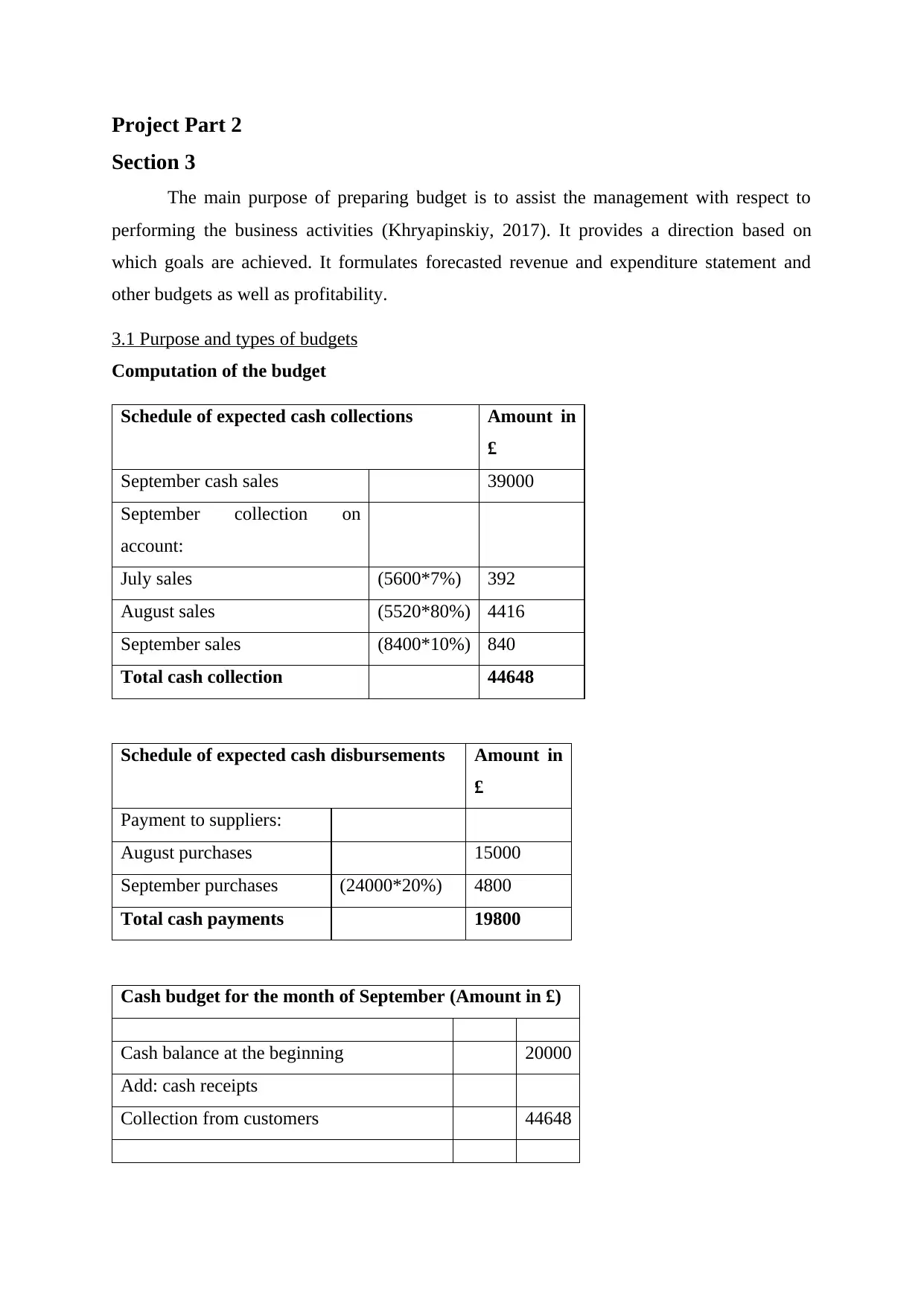
Project Part 2
Section 3
The main purpose of preparing budget is to assist the management with respect to
performing the business activities (Khryapinskiy, 2017). It provides a direction based on
which goals are achieved. It formulates forecasted revenue and expenditure statement and
other budgets as well as profitability.
3.1 Purpose and types of budgets
Computation of the budget
Schedule of expected cash collections Amount in
£
September cash sales 39000
September collection on
account:
July sales (5600*7%) 392
August sales (5520*80%) 4416
September sales (8400*10%) 840
Total cash collection 44648
Schedule of expected cash disbursements Amount in
£
Payment to suppliers:
August purchases 15000
September purchases (24000*20%) 4800
Total cash payments 19800
Cash budget for the month of September (Amount in £)
Cash balance at the beginning 20000
Add: cash receipts
Collection from customers 44648
Section 3
The main purpose of preparing budget is to assist the management with respect to
performing the business activities (Khryapinskiy, 2017). It provides a direction based on
which goals are achieved. It formulates forecasted revenue and expenditure statement and
other budgets as well as profitability.
3.1 Purpose and types of budgets
Computation of the budget
Schedule of expected cash collections Amount in
£
September cash sales 39000
September collection on
account:
July sales (5600*7%) 392
August sales (5520*80%) 4416
September sales (8400*10%) 840
Total cash collection 44648
Schedule of expected cash disbursements Amount in
£
Payment to suppliers:
August purchases 15000
September purchases (24000*20%) 4800
Total cash payments 19800
Cash budget for the month of September (Amount in £)
Cash balance at the beginning 20000
Add: cash receipts
Collection from customers 44648
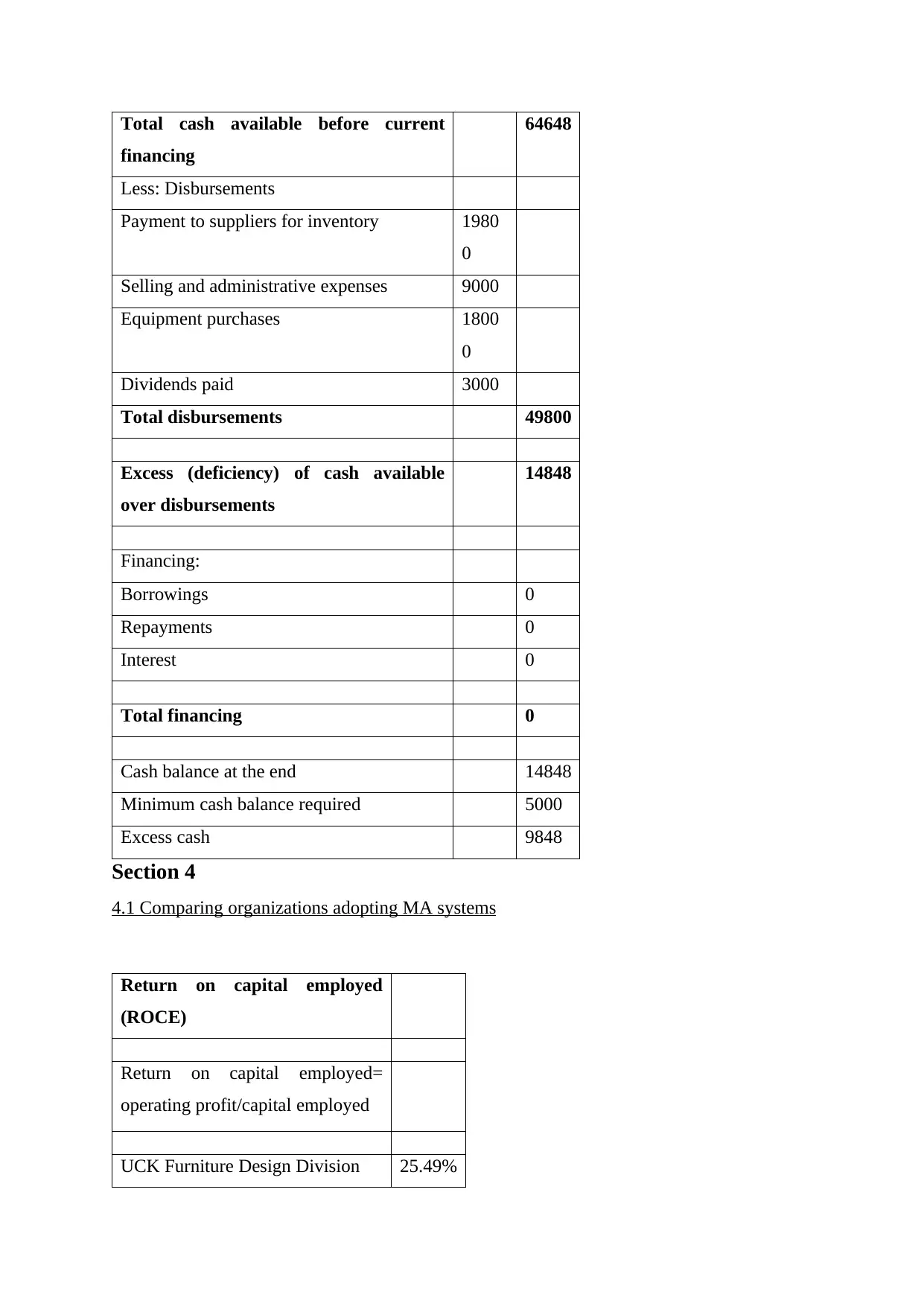
Total cash available before current
financing
64648
Less: Disbursements
Payment to suppliers for inventory 1980
0
Selling and administrative expenses 9000
Equipment purchases 1800
0
Dividends paid 3000
Total disbursements 49800
Excess (deficiency) of cash available
over disbursements
14848
Financing:
Borrowings 0
Repayments 0
Interest 0
Total financing 0
Cash balance at the end 14848
Minimum cash balance required 5000
Excess cash 9848
Section 4
4.1 Comparing organizations adopting MA systems
Return on capital employed
(ROCE)
Return on capital employed=
operating profit/capital employed
UCK Furniture Design Division 25.49%
financing
64648
Less: Disbursements
Payment to suppliers for inventory 1980
0
Selling and administrative expenses 9000
Equipment purchases 1800
0
Dividends paid 3000
Total disbursements 49800
Excess (deficiency) of cash available
over disbursements
14848
Financing:
Borrowings 0
Repayments 0
Interest 0
Total financing 0
Cash balance at the end 14848
Minimum cash balance required 5000
Excess cash 9848
Section 4
4.1 Comparing organizations adopting MA systems
Return on capital employed
(ROCE)
Return on capital employed=
operating profit/capital employed
UCK Furniture Design Division 25.49%
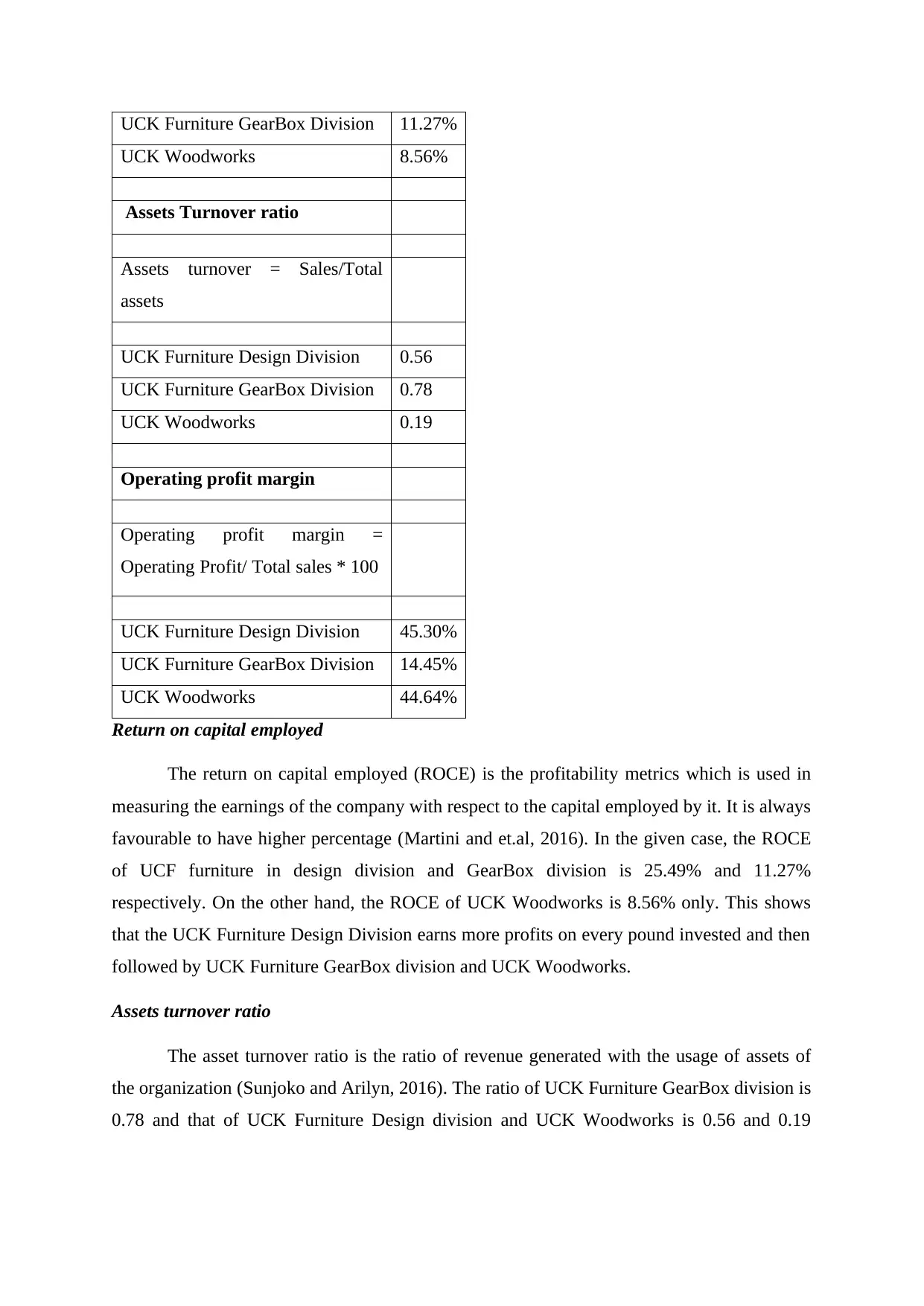
UCK Furniture GearBox Division 11.27%
UCK Woodworks 8.56%
Assets Turnover ratio
Assets turnover = Sales/Total
assets
UCK Furniture Design Division 0.56
UCK Furniture GearBox Division 0.78
UCK Woodworks 0.19
Operating profit margin
Operating profit margin =
Operating Profit/ Total sales * 100
UCK Furniture Design Division 45.30%
UCK Furniture GearBox Division 14.45%
UCK Woodworks 44.64%
Return on capital employed
The return on capital employed (ROCE) is the profitability metrics which is used in
measuring the earnings of the company with respect to the capital employed by it. It is always
favourable to have higher percentage (Martini and et.al, 2016). In the given case, the ROCE
of UCF furniture in design division and GearBox division is 25.49% and 11.27%
respectively. On the other hand, the ROCE of UCK Woodworks is 8.56% only. This shows
that the UCK Furniture Design Division earns more profits on every pound invested and then
followed by UCK Furniture GearBox division and UCK Woodworks.
Assets turnover ratio
The asset turnover ratio is the ratio of revenue generated with the usage of assets of
the organization (Sunjoko and Arilyn, 2016). The ratio of UCK Furniture GearBox division is
0.78 and that of UCK Furniture Design division and UCK Woodworks is 0.56 and 0.19
UCK Woodworks 8.56%
Assets Turnover ratio
Assets turnover = Sales/Total
assets
UCK Furniture Design Division 0.56
UCK Furniture GearBox Division 0.78
UCK Woodworks 0.19
Operating profit margin
Operating profit margin =
Operating Profit/ Total sales * 100
UCK Furniture Design Division 45.30%
UCK Furniture GearBox Division 14.45%
UCK Woodworks 44.64%
Return on capital employed
The return on capital employed (ROCE) is the profitability metrics which is used in
measuring the earnings of the company with respect to the capital employed by it. It is always
favourable to have higher percentage (Martini and et.al, 2016). In the given case, the ROCE
of UCF furniture in design division and GearBox division is 25.49% and 11.27%
respectively. On the other hand, the ROCE of UCK Woodworks is 8.56% only. This shows
that the UCK Furniture Design Division earns more profits on every pound invested and then
followed by UCK Furniture GearBox division and UCK Woodworks.
Assets turnover ratio
The asset turnover ratio is the ratio of revenue generated with the usage of assets of
the organization (Sunjoko and Arilyn, 2016). The ratio of UCK Furniture GearBox division is
0.78 and that of UCK Furniture Design division and UCK Woodworks is 0.56 and 0.19
Paraphrase This Document
Need a fresh take? Get an instant paraphrase of this document with our AI Paraphraser
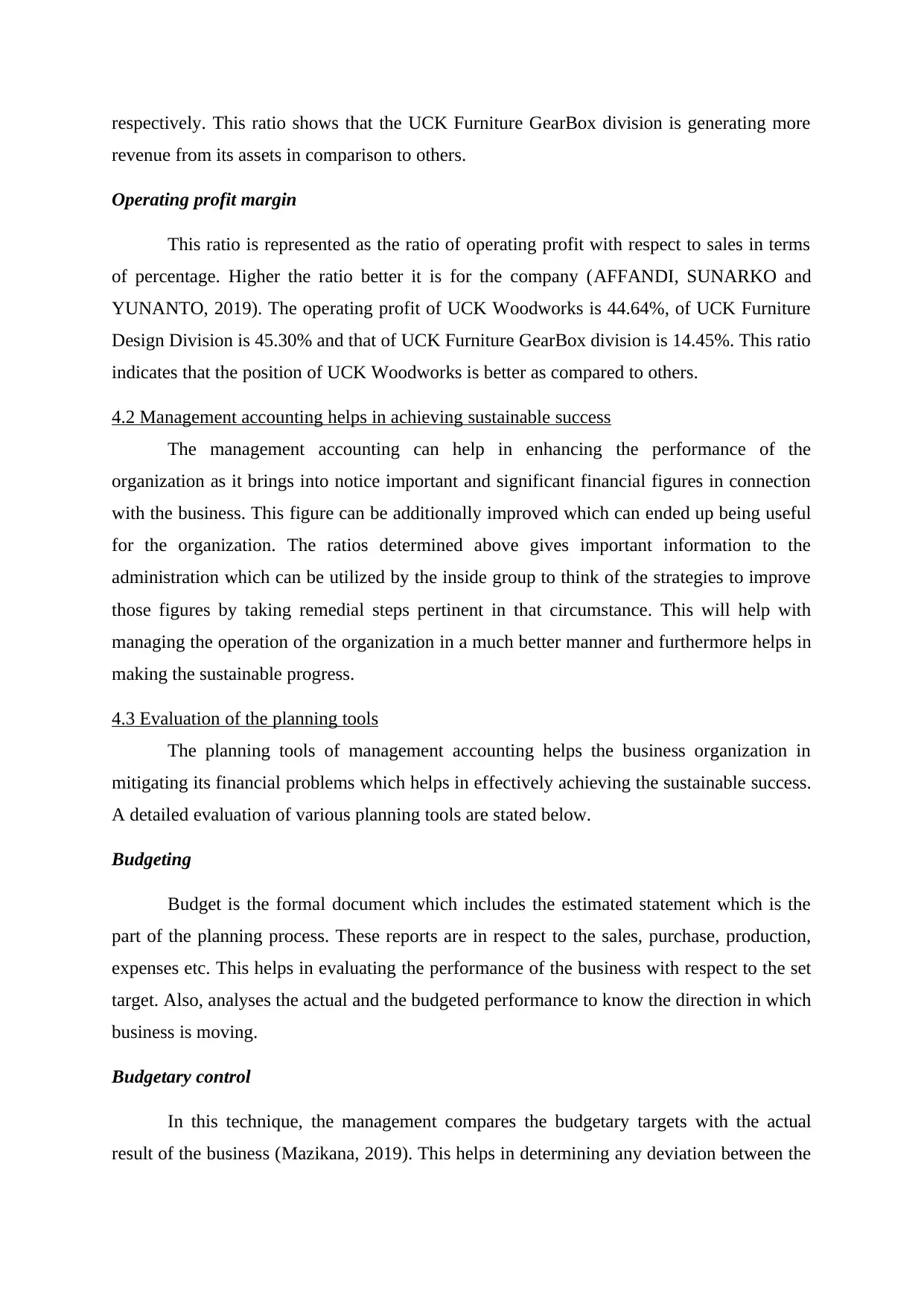
respectively. This ratio shows that the UCK Furniture GearBox division is generating more
revenue from its assets in comparison to others.
Operating profit margin
This ratio is represented as the ratio of operating profit with respect to sales in terms
of percentage. Higher the ratio better it is for the company (AFFANDI, SUNARKO and
YUNANTO, 2019). The operating profit of UCK Woodworks is 44.64%, of UCK Furniture
Design Division is 45.30% and that of UCK Furniture GearBox division is 14.45%. This ratio
indicates that the position of UCK Woodworks is better as compared to others.
4.2 Management accounting helps in achieving sustainable success
The management accounting can help in enhancing the performance of the
organization as it brings into notice important and significant financial figures in connection
with the business. This figure can be additionally improved which can ended up being useful
for the organization. The ratios determined above gives important information to the
administration which can be utilized by the inside group to think of the strategies to improve
those figures by taking remedial steps pertinent in that circumstance. This will help with
managing the operation of the organization in a much better manner and furthermore helps in
making the sustainable progress.
4.3 Evaluation of the planning tools
The planning tools of management accounting helps the business organization in
mitigating its financial problems which helps in effectively achieving the sustainable success.
A detailed evaluation of various planning tools are stated below.
Budgeting
Budget is the formal document which includes the estimated statement which is the
part of the planning process. These reports are in respect to the sales, purchase, production,
expenses etc. This helps in evaluating the performance of the business with respect to the set
target. Also, analyses the actual and the budgeted performance to know the direction in which
business is moving.
Budgetary control
In this technique, the management compares the budgetary targets with the actual
result of the business (Mazikana, 2019). This helps in determining any deviation between the
revenue from its assets in comparison to others.
Operating profit margin
This ratio is represented as the ratio of operating profit with respect to sales in terms
of percentage. Higher the ratio better it is for the company (AFFANDI, SUNARKO and
YUNANTO, 2019). The operating profit of UCK Woodworks is 44.64%, of UCK Furniture
Design Division is 45.30% and that of UCK Furniture GearBox division is 14.45%. This ratio
indicates that the position of UCK Woodworks is better as compared to others.
4.2 Management accounting helps in achieving sustainable success
The management accounting can help in enhancing the performance of the
organization as it brings into notice important and significant financial figures in connection
with the business. This figure can be additionally improved which can ended up being useful
for the organization. The ratios determined above gives important information to the
administration which can be utilized by the inside group to think of the strategies to improve
those figures by taking remedial steps pertinent in that circumstance. This will help with
managing the operation of the organization in a much better manner and furthermore helps in
making the sustainable progress.
4.3 Evaluation of the planning tools
The planning tools of management accounting helps the business organization in
mitigating its financial problems which helps in effectively achieving the sustainable success.
A detailed evaluation of various planning tools are stated below.
Budgeting
Budget is the formal document which includes the estimated statement which is the
part of the planning process. These reports are in respect to the sales, purchase, production,
expenses etc. This helps in evaluating the performance of the business with respect to the set
target. Also, analyses the actual and the budgeted performance to know the direction in which
business is moving.
Budgetary control
In this technique, the management compares the budgetary targets with the actual
result of the business (Mazikana, 2019). This helps in determining any deviation between the
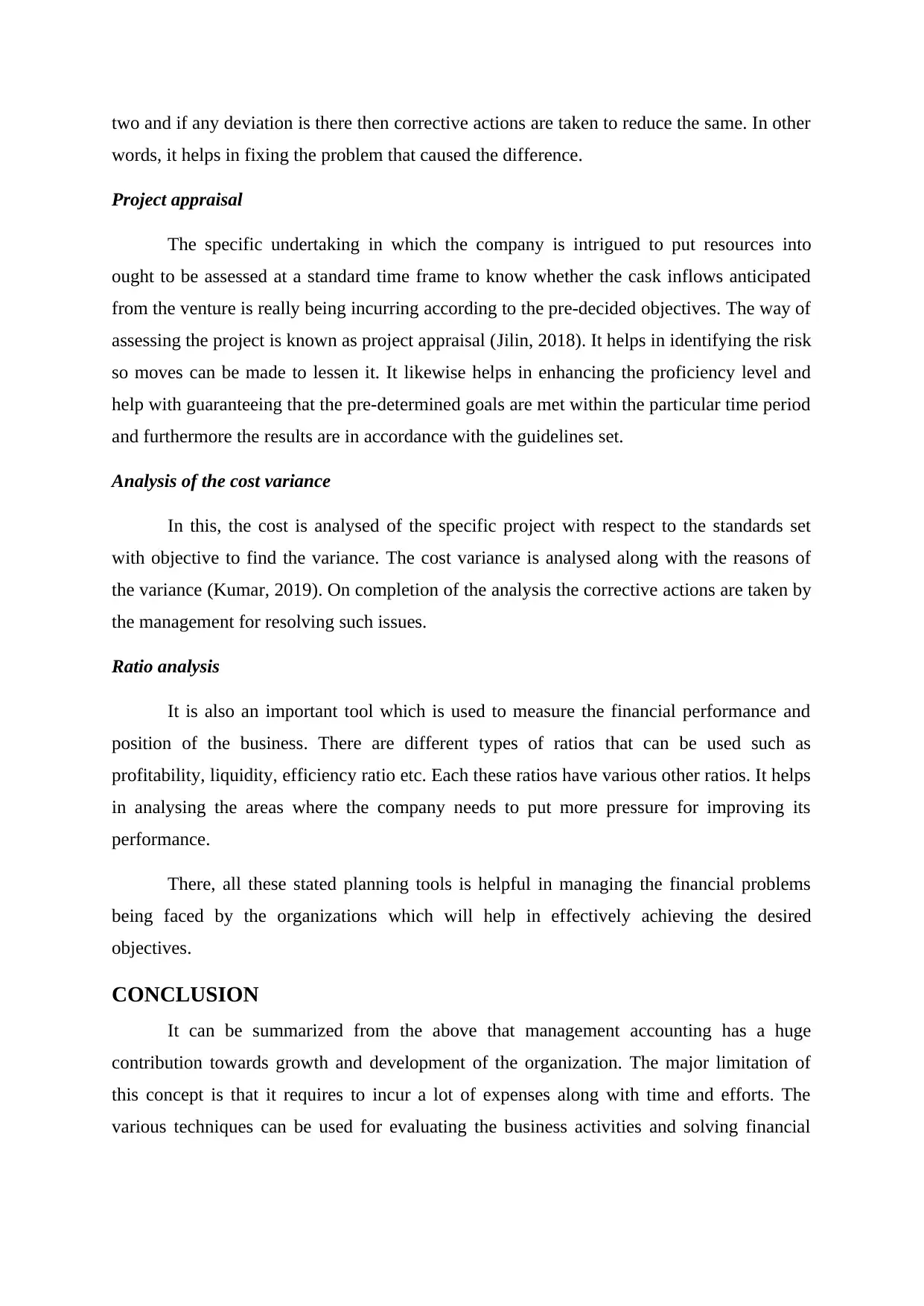
two and if any deviation is there then corrective actions are taken to reduce the same. In other
words, it helps in fixing the problem that caused the difference.
Project appraisal
The specific undertaking in which the company is intrigued to put resources into
ought to be assessed at a standard time frame to know whether the cask inflows anticipated
from the venture is really being incurring according to the pre-decided objectives. The way of
assessing the project is known as project appraisal (Jilin, 2018). It helps in identifying the risk
so moves can be made to lessen it. It likewise helps in enhancing the proficiency level and
help with guaranteeing that the pre-determined goals are met within the particular time period
and furthermore the results are in accordance with the guidelines set.
Analysis of the cost variance
In this, the cost is analysed of the specific project with respect to the standards set
with objective to find the variance. The cost variance is analysed along with the reasons of
the variance (Kumar, 2019). On completion of the analysis the corrective actions are taken by
the management for resolving such issues.
Ratio analysis
It is also an important tool which is used to measure the financial performance and
position of the business. There are different types of ratios that can be used such as
profitability, liquidity, efficiency ratio etc. Each these ratios have various other ratios. It helps
in analysing the areas where the company needs to put more pressure for improving its
performance.
There, all these stated planning tools is helpful in managing the financial problems
being faced by the organizations which will help in effectively achieving the desired
objectives.
CONCLUSION
It can be summarized from the above that management accounting has a huge
contribution towards growth and development of the organization. The major limitation of
this concept is that it requires to incur a lot of expenses along with time and efforts. The
various techniques can be used for evaluating the business activities and solving financial
words, it helps in fixing the problem that caused the difference.
Project appraisal
The specific undertaking in which the company is intrigued to put resources into
ought to be assessed at a standard time frame to know whether the cask inflows anticipated
from the venture is really being incurring according to the pre-decided objectives. The way of
assessing the project is known as project appraisal (Jilin, 2018). It helps in identifying the risk
so moves can be made to lessen it. It likewise helps in enhancing the proficiency level and
help with guaranteeing that the pre-determined goals are met within the particular time period
and furthermore the results are in accordance with the guidelines set.
Analysis of the cost variance
In this, the cost is analysed of the specific project with respect to the standards set
with objective to find the variance. The cost variance is analysed along with the reasons of
the variance (Kumar, 2019). On completion of the analysis the corrective actions are taken by
the management for resolving such issues.
Ratio analysis
It is also an important tool which is used to measure the financial performance and
position of the business. There are different types of ratios that can be used such as
profitability, liquidity, efficiency ratio etc. Each these ratios have various other ratios. It helps
in analysing the areas where the company needs to put more pressure for improving its
performance.
There, all these stated planning tools is helpful in managing the financial problems
being faced by the organizations which will help in effectively achieving the desired
objectives.
CONCLUSION
It can be summarized from the above that management accounting has a huge
contribution towards growth and development of the organization. The major limitation of
this concept is that it requires to incur a lot of expenses along with time and efforts. The
various techniques can be used for evaluating the business activities and solving financial
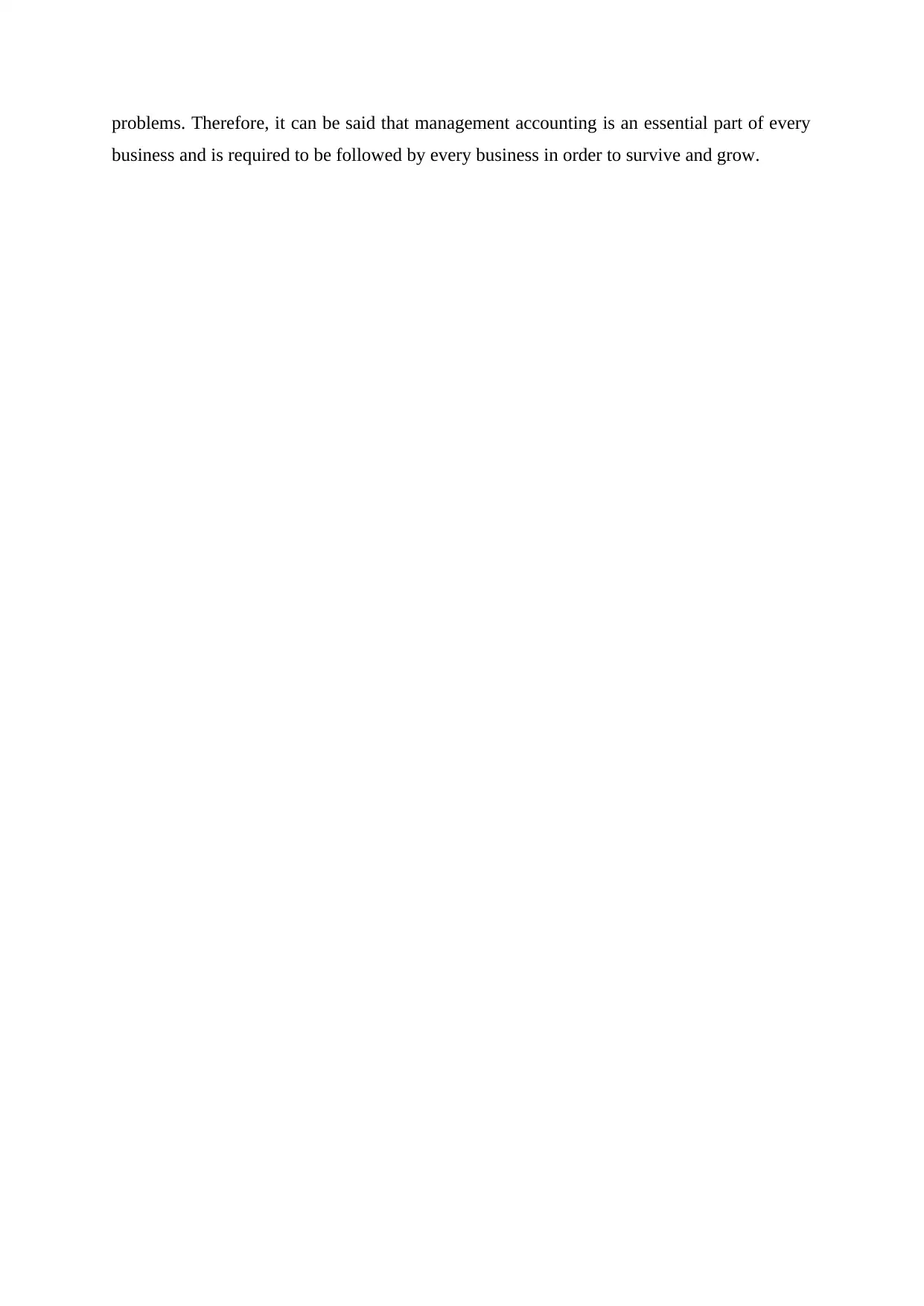
problems. Therefore, it can be said that management accounting is an essential part of every
business and is required to be followed by every business in order to survive and grow.
business and is required to be followed by every business in order to survive and grow.
Secure Best Marks with AI Grader
Need help grading? Try our AI Grader for instant feedback on your assignments.
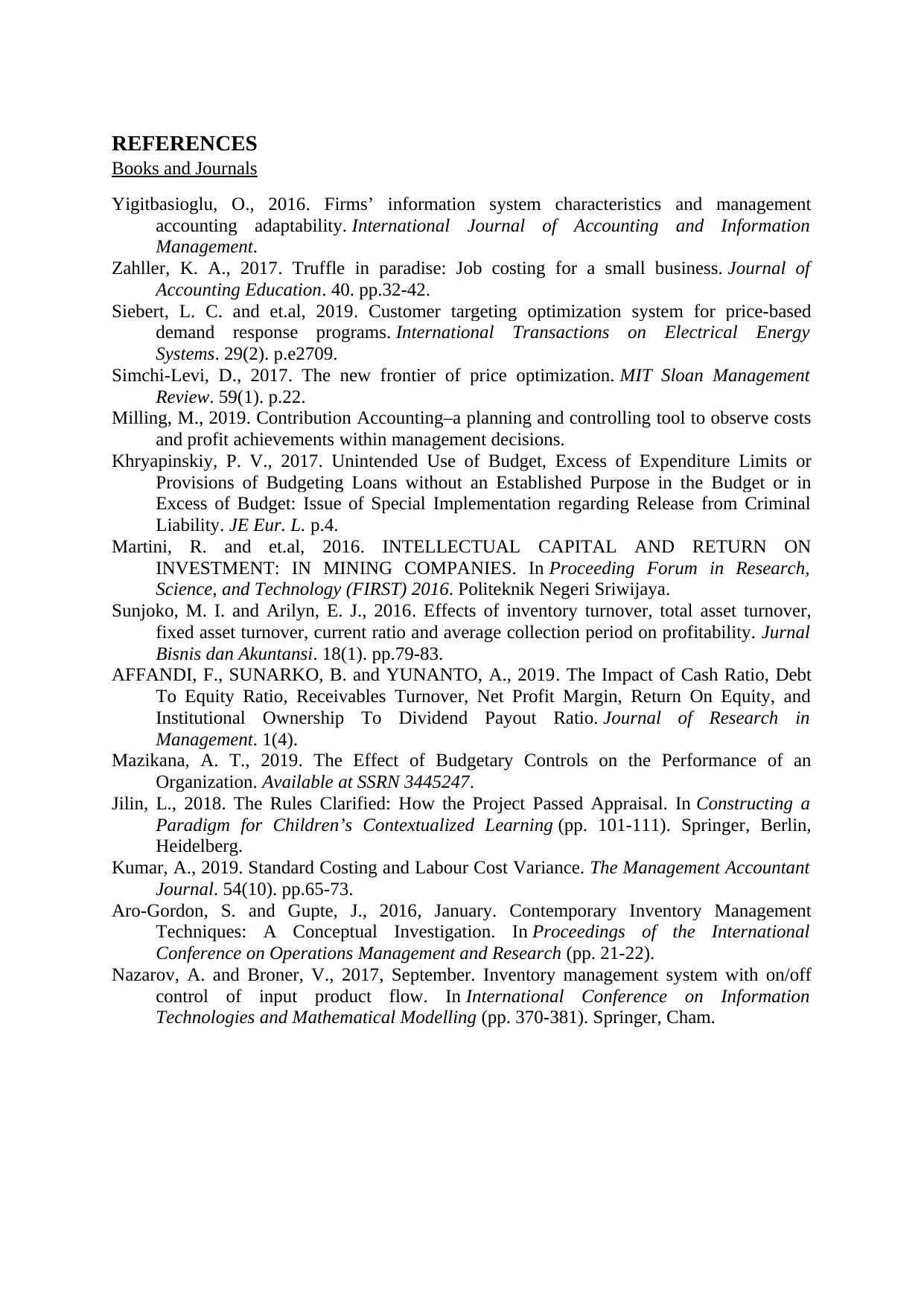
REFERENCES
Books and Journals
Yigitbasioglu, O., 2016. Firms’ information system characteristics and management
accounting adaptability. International Journal of Accounting and Information
Management.
Zahller, K. A., 2017. Truffle in paradise: Job costing for a small business. Journal of
Accounting Education. 40. pp.32-42.
Siebert, L. C. and et.al, 2019. Customer targeting optimization system for price‐based
demand response programs. International Transactions on Electrical Energy
Systems. 29(2). p.e2709.
Simchi-Levi, D., 2017. The new frontier of price optimization. MIT Sloan Management
Review. 59(1). p.22.
Milling, M., 2019. Contribution Accounting–a planning and controlling tool to observe costs
and profit achievements within management decisions.
Khryapinskiy, P. V., 2017. Unintended Use of Budget, Excess of Expenditure Limits or
Provisions of Budgeting Loans without an Established Purpose in the Budget or in
Excess of Budget: Issue of Special Implementation regarding Release from Criminal
Liability. JE Eur. L. p.4.
Martini, R. and et.al, 2016. INTELLECTUAL CAPITAL AND RETURN ON
INVESTMENT: IN MINING COMPANIES. In Proceeding Forum in Research,
Science, and Technology (FIRST) 2016. Politeknik Negeri Sriwijaya.
Sunjoko, M. I. and Arilyn, E. J., 2016. Effects of inventory turnover, total asset turnover,
fixed asset turnover, current ratio and average collection period on profitability. Jurnal
Bisnis dan Akuntansi. 18(1). pp.79-83.
AFFANDI, F., SUNARKO, B. and YUNANTO, A., 2019. The Impact of Cash Ratio, Debt
To Equity Ratio, Receivables Turnover, Net Profit Margin, Return On Equity, and
Institutional Ownership To Dividend Payout Ratio. Journal of Research in
Management. 1(4).
Mazikana, A. T., 2019. The Effect of Budgetary Controls on the Performance of an
Organization. Available at SSRN 3445247.
Jilin, L., 2018. The Rules Clarified: How the Project Passed Appraisal. In Constructing a
Paradigm for Children’s Contextualized Learning (pp. 101-111). Springer, Berlin,
Heidelberg.
Kumar, A., 2019. Standard Costing and Labour Cost Variance. The Management Accountant
Journal. 54(10). pp.65-73.
Aro-Gordon, S. and Gupte, J., 2016, January. Contemporary Inventory Management
Techniques: A Conceptual Investigation. In Proceedings of the International
Conference on Operations Management and Research (pp. 21-22).
Nazarov, A. and Broner, V., 2017, September. Inventory management system with on/off
control of input product flow. In International Conference on Information
Technologies and Mathematical Modelling (pp. 370-381). Springer, Cham.
Books and Journals
Yigitbasioglu, O., 2016. Firms’ information system characteristics and management
accounting adaptability. International Journal of Accounting and Information
Management.
Zahller, K. A., 2017. Truffle in paradise: Job costing for a small business. Journal of
Accounting Education. 40. pp.32-42.
Siebert, L. C. and et.al, 2019. Customer targeting optimization system for price‐based
demand response programs. International Transactions on Electrical Energy
Systems. 29(2). p.e2709.
Simchi-Levi, D., 2017. The new frontier of price optimization. MIT Sloan Management
Review. 59(1). p.22.
Milling, M., 2019. Contribution Accounting–a planning and controlling tool to observe costs
and profit achievements within management decisions.
Khryapinskiy, P. V., 2017. Unintended Use of Budget, Excess of Expenditure Limits or
Provisions of Budgeting Loans without an Established Purpose in the Budget or in
Excess of Budget: Issue of Special Implementation regarding Release from Criminal
Liability. JE Eur. L. p.4.
Martini, R. and et.al, 2016. INTELLECTUAL CAPITAL AND RETURN ON
INVESTMENT: IN MINING COMPANIES. In Proceeding Forum in Research,
Science, and Technology (FIRST) 2016. Politeknik Negeri Sriwijaya.
Sunjoko, M. I. and Arilyn, E. J., 2016. Effects of inventory turnover, total asset turnover,
fixed asset turnover, current ratio and average collection period on profitability. Jurnal
Bisnis dan Akuntansi. 18(1). pp.79-83.
AFFANDI, F., SUNARKO, B. and YUNANTO, A., 2019. The Impact of Cash Ratio, Debt
To Equity Ratio, Receivables Turnover, Net Profit Margin, Return On Equity, and
Institutional Ownership To Dividend Payout Ratio. Journal of Research in
Management. 1(4).
Mazikana, A. T., 2019. The Effect of Budgetary Controls on the Performance of an
Organization. Available at SSRN 3445247.
Jilin, L., 2018. The Rules Clarified: How the Project Passed Appraisal. In Constructing a
Paradigm for Children’s Contextualized Learning (pp. 101-111). Springer, Berlin,
Heidelberg.
Kumar, A., 2019. Standard Costing and Labour Cost Variance. The Management Accountant
Journal. 54(10). pp.65-73.
Aro-Gordon, S. and Gupte, J., 2016, January. Contemporary Inventory Management
Techniques: A Conceptual Investigation. In Proceedings of the International
Conference on Operations Management and Research (pp. 21-22).
Nazarov, A. and Broner, V., 2017, September. Inventory management system with on/off
control of input product flow. In International Conference on Information
Technologies and Mathematical Modelling (pp. 370-381). Springer, Cham.
1 out of 17
Related Documents
Your All-in-One AI-Powered Toolkit for Academic Success.
+13062052269
info@desklib.com
Available 24*7 on WhatsApp / Email
![[object Object]](/_next/static/media/star-bottom.7253800d.svg)
Unlock your academic potential
© 2024 | Zucol Services PVT LTD | All rights reserved.





